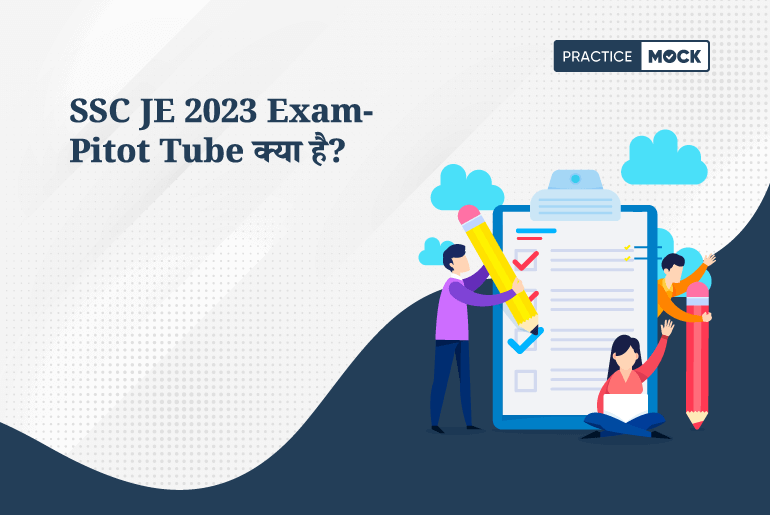A Pitot-tube is a tool used to figure out how fast water flows in a pipe or channel at a particular spot. It works like this: when water slows down at a certain point, the pressure there goes up because the speedy energy of the water gets turned into pressure. Imagine the Pitot-tube as a glass tube with a 90-degree bend. The bent part points upstream, where the water’s coming from. When you put the tube in the water, the liquid inside rises up because that kinetic energy it had from the flowing water turns into pressure energy. We can find out how fast the water’s moving by measuring how high the liquid goes up inside the tube. It’s a clever way to gauge water speed!
In this blog, we’ll supply you with some practice questions, and points to master Pitot Tube!
SSC JE 2023 Mock Test for Ultimate Practice
FREE SSC JE Civil Engineering 2023 Mock Test: Are You Ready for the Challenge? Find Out Now!
How it works?
The Pitot tube typically consists of a hollow tube with one open end (facing the oncoming fluid) and one closed end. When the tube is placed in a moving fluid, such as the air around an aircraft or the water in a river, the open end faces into the fluid flow, while the closed end remains static. This design allows the Pitot tube to measure the dynamic pressure of the fluid, which is related to its velocity.
By measuring the difference between the static pressure (at the closed end) and the dynamic pressure (at the open end), the Pitot tube can determine the velocity of the fluid. This principle is based on Bernoulli’s equation, which relates fluid velocity to pressure.
Understanding how a Pitot tube works and its applications in fluid velocity measurement can be beneficial for candidates preparing for the upcoming SSC JE 2023 exam.
PITOT TUBE

Important Points
- The pitot tube is the simplest form of Bernoulli. It is used to measure the speed of fluid flow in an open tube. It is an L-shaped bent glass tube open at both ends.
- It is based on principle of conversion of kinetic head into pressure head. The point at which velocity reduces to zero is called stagnation point.



where CV = coefficient of velocity = 0.98
PS/rg = stagnation head.
P0/rg = static head.
* The pitot tube measure the total head and there fore known as total head tube.
Q. The velocity of a water stream is being measured by a L-shaped pitot-tube and the readings is 20 cm. Then, what is the approximate value of velocity?
(a) 196 m/s (b) 2 m/s
(c) 98 m/s (d) 20 m/s
Ans -2
3 Practice Questions
Here are three expected objective-type tough questions related to Pitot tubes and fluid dynamics for the SSC JE 2023 Exam:
Question 1:
Which principle forms the basis for the operation of a Pitot tube in measuring fluid velocity?
a) Archimedes’ principle
b) Pascal’s principle
c) Bernoulli’s principle
d) Newton’s third law
Question 2:
In an aircraft, a Pitot tube is used to measure the:
a) Static pressure of the air
b) Total pressure of the air
c) Velocity of the aircraft
d) Atmospheric pressure
Question 3:
If a Pitot tube is placed in a fluid flow, which pressure does it measure at the open end?
a) Static pressure
b) Dynamic pressure
c) Atmospheric pressure
d) Hydrostatic pressure
Answers
Here are the answers to the three tough questions:
Question 1:
Which principle forms the basis for the operation of a Pitot tube in measuring fluid velocity?
Correct Answer: c) Bernoulli’s principle
Question 2:
In an aircraft, a Pitot tube is used to measure the:
Correct Answer: b) Total pressure of the air
Question 3:
If a Pitot tube is placed in a fluid flow, which pressure does it measure at the open end?
Correct Answer: b) Dynamic pressure
These answers reflect the principles and applications of Pitot tubes in fluid dynamics. Keep practicing Mock Tests to improve your knowledge for the SSC JE Exam!
Note: These questions are designed to test your knowledge of the principles behind Pitot tubes and their applications in fluid dynamics.
Good luck with your SSC JE Exam preparation!
- Sign Up on Practicemock for Updated Current Affairs, Free Topic Tests and Free Mini Mocks
- Sign Up Here to Download Free Study Material
Free Mock Tests for the Upcoming Exams
- IBPS PO Free Mock Test 2024
- RBI Grade B Free Mock Test 2024
- IBPS SO Free Mock Test 2024
- NABARD Grade A Free Mock Test 2024
- SSC CGL Free Mock Test 2024
- IBPS Clerk Free Mock Test 2024
- IBPS RRB PO Free Mock Test 2024
- IBPS RRB Clerk Free Mock Test 2024
- RRB NTPC Free Mock Test 2024
- SSC MTS Free Mock Test 2024
- SSC Strenographer Free Mock Test 2024
- GATE Mechanical Free Mock Test 2024
- GATE Civil Free Mock Test 2024
- RRB ALP Free Mock Test 2024
- SSC CPO Free Mock Test 2024
- AFCAT Free Mock Test 2024
- SEBI Grade A Free Mock Test 2024
- IFSCA Grade A Free Mock Test 2024
- RRB JE Free Mock Test 2024
- Free Banking Live Test
- Free SSC Live Test


